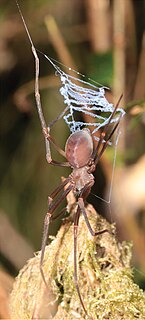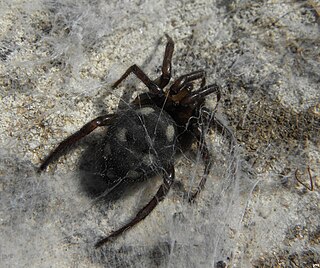
The Mygalomorphae, or mygalomorphs, are an infraorder of spiders. The name is derived from the Greek mygalē, meaning "shrew", plus morphē meaning form or shape. An older name for the group is Orthognatha, derived from the orientation of the fangs which point straight down and do not cross each other. In 1802, Charles Athanase Walckenaer separated mygalomorph spiders into a separate genus, Mygale, leaving all other spiders in Aranea.

Huntsman spiders, members of the family Sparassidae, are known by this name because of their speed and mode of hunting. They are also called giant crab spiders because of their size and appearance. Larger species sometimes are referred to as wood spiders, because of their preference for woody places. In southern Africa the genus Palystes are known as rain spiders or lizard-eating spiders. Commonly they are confused with baboon spiders from the Mygalomorphae infraorder, which are not closely related.

The Pholcidae are a family of araneomorph spiders. The family contains over 1,800 pholcids, including those commonly known as the marbled cellar spider , daddy long-legs spider, granddaddy long-legs spider, carpenter spider, daddy long-legger, vibrating spider, gyrating spider, long daddy, and skull spider. The family, first described by Carl Ludwig Koch in 1850, is divided into 94 genera.

Scaffold web spiders (Nesticidae) is a family of araneomorph spiders closely allied with tangle web spiders. Like the "Theridiidae", these spiders have a comb of serrated bristles on the hind tarsi that are used to pull silk bands from the spinnerets. It contains 16 genera and about 300 species, many of which are associated with caves or overhangs. The genus Nesticus is the type for the family and is found throughout the world. The related Eidmannella has speciated considerably in Texas caves and includes some extremely localized species that are considered threatened. One species, Eidmannella pallida, is found in caves and under overhangs, but also in agricultural fields and other habitats away from such restricted areas. The genus Carpathonesticus is found in central Eurasia.

Cribellum literally means "little sieve", and in biology the term generally applies to anatomical structures in the form of tiny perforated plates.

Idiopidae, also known as armored trapdoor spiders, is a family of mygalomorph spiders first described by Eugène Simon in 1889. They have a large body similar to tarantulas.

Oecobius navus is a small cosmopolitan cribellate spider species of about 2-3mm. It is light grey with darkly annulated legs. It builds flat webs with lateral openings with a diameter of about 3 cm under rocks, on ceilings and along the corners of walls with protruding signaling threads.

Uroctea is a genus of spiders that is found in Eurasia and Africa. It is sometimes put into its own family, Urocteidae. Their tent-like web is very similar to the ones Oecobius builds; but Uroctea species do not have a cribellum.

Alireza Zamani is an Iranian arachnologist and taxonomist.
Castianeira occidens is a species of true spider in the family Corinnidae. It is found in the United States and Mexico.

Phidippus carneus is a species of jumping spider in the family Salticidae. It is found in the United States and Mexico.

Cybaeota shastae is a species of true spider in the family Cybaeidae. It is found in the United States.

Hypochilus coylei is a species of lampshade weaver in the family of spiders known as Hypochilidae. It is found in the United States. This species inhabits a 35 mile north-south corridor of mountain range in western North Carolina. This species has a two year life cycle and feeds on crickets and spiders.
Linyphantes pualla is a species of sheetweb spider in the family Linyphiidae. It is found in the United States and Canada.

Pimoa altioculata is a species of true spider in the family Pimoidae. It is found in the United States and Canada.
Pholcophora americana is a species of cellar spider in the family Pholcidae. It is found in the United States and Canada.
Orodrassus canadensis is a species of ground spider in the family Gnaphosidae. It is found in the United States and Canada.
Tidarren haemorrhoidale is a species of spider in the family Theridiidae. It is found in a range from the United States to Argentina.

Castianeira gertschi, the Gertsch antmimic, is a species of true spider in the family Corinnidae. It is found in the United States and Canada.

Dolomedes albineus, the white-banded fishing spider, is a species of nursery web spider in the family Pisauridae. It is found in the United States. Like most Dolomedes, this spider tends to hunt at or in streams and ponds. It has special hairs that repel water, allowing it to walk on water, and trap an air bubble on its abdomen to dive and swim, so that it can hunt tadpoles and aquatic invertebrates.















